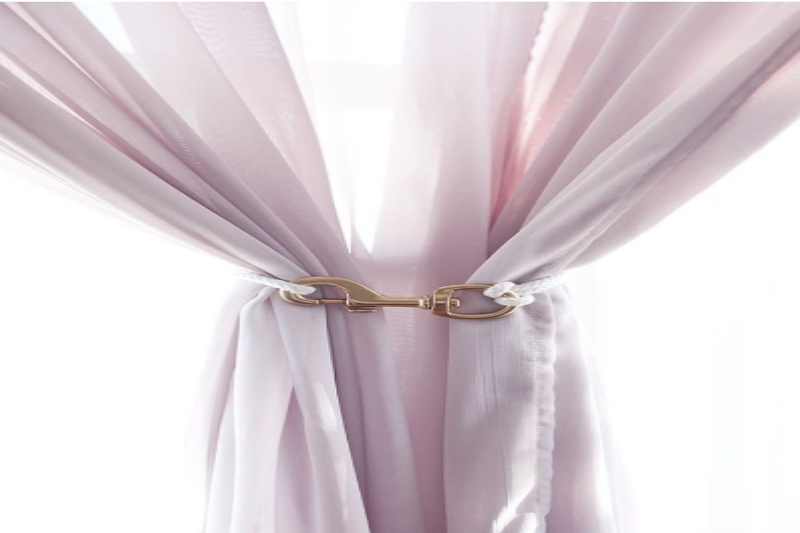We all know how hard it can be to tie curtains back, especially if the curtain rod is out of reach. It’s time to throw out that old way of tying curtains and learn how you can do it without a struggle! This article will show you how to tie curtains back with ease and in style!

Steps on How to Tie Curtains Back
Step #1: Cut your tie, about six inches long. You can choose to make it longer if you want a thicker rope or shorter for a finer line.
Step #2: Take one end of the fabric and place it over your elbow so that there is some tension in the fabric. This will help create more space between the fabric and the ceiling, so it’s easier to tie.
Step #3: Tie a knot on one end of your fabric using that elbow as the guide for how long you want it.
Once you’ve done this, hold onto both ends of the fabric tightly with each hand. With your right hand, pull up from underneath while pulling down with your left hand.
This will create a knot that is tight and secure but still has give to it so you can tie it up against the ceiling with ease.
Step #4: Hold on tightly to both ends of the fabric and pull them in opposite directions until they are about six inches apart from each other.
Lay your hands down flat in front of you, then take both hands and wrap them around the fabric.
Step #5: Take your left hand in front of your right, with each arm holding onto about three feet or so of fabric from one side. Put your palm up flat against each other as if you’re praying–this is how you’ll begin to tie a double knot.
Why Should You Tie Your Curtains Back?
#1. Reclaim space and light. Curtains are bulky, so when you tie them back they take up much less room in the house and let more natural light into the room.
This is particularly valuable if your windows face a busy street or people’s houses–you’ll have an easier time reading without glare on your monitor screen or watching TV without glare on the screen.
# 2. Prevent sunlight from damaging your furniture or walls. Curtains often get bunched up when they’re not tied back–in some cases, this can cause a lot of damage to delicate surfaces like wood and stone, as well as limit how much light, gets in throughout the day.
#3. Keep dust particles out. When curtains are tied back it will help to keep the house cleaner and fresher because dust particles that collect on the floorboards or furniture won’t be able to get onto your curtain fabric.
#4. Prevent drafts. If you live in a drafty house, tying back your curtains can help to keep the temperature more balanced inside and out–it’s especially important if someone is home all day or if there are pets who might not be warm enough otherwise.
How to Care for Curtains
Tip #1. Don’t dry clean too often. Dry cleaning is usually best for the more delicate fabrics and it’s not recommended that curtains be dry cleaned more than twice a year–especially when they’re lined; this helps to preserve their lining and keep them looking nicer longer.
Tip #2. Iron or steam if necessary. If you’ve hung your curtains in the past and they’ve gotten a little droopy, try to iron them or use your steamer.
Tip #3. Wash when necessary. When you wash curtains (either by hand or in the washing machine), make sure to turn them inside out so that the lining is touching the fabric; this will keep it from getting discolored over time.
Tip #4. Hang curtains in the right direction. When you hang your curtain, make sure that it is hung so there’s a little bit of overhang on either side to keep bugs from getting inside! This will also help with privacy and insulation.
Tip #5. Use weights or hooks if necessary. These are especially helpful for heavier fabrics like blackout curtains.
Tip #6. Keep the curtain rod evenly spaced from the wall. It’s a good idea to measure and mark where your curtains will hang before you start so that they’re exactly even on either side of the window!
How Often Should I Dye Curtains?
Tip #1. If you have special curtains that need to be dyed after a certain time, just make sure to follow the directions on how often they should be washed and dried before dyeing. Otherwise, it’s like anything else – once every six months is usually sufficient.
Tip #2. To avoid fading or worsening discoloration from sun exposure, keep your curtains in the shade when not in use!
Is Bleaching Good for my Curtain?
If your curtains are not white, you will need to use bleach that is suited for the fabric they’re made of.
What Kind of Detergent Should I use on my Curtains?
When you wash your curtains, make sure to use a colorfast detergent that is specifically made for washing fabrics.
What Kind of Stain Remover should I use on my Curtain?
If there’s anything else on the fabric other than water (maybe some grass stains or wine), consider using an enzymatic cleaner to help remove the stain.
